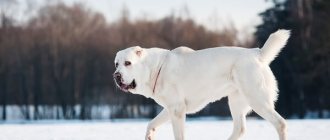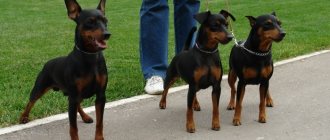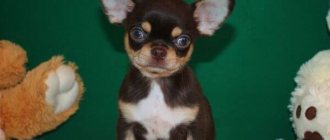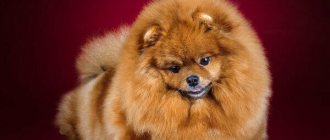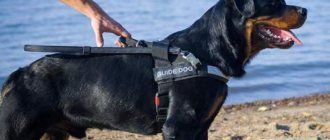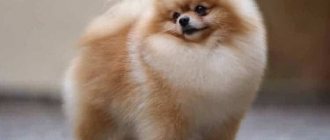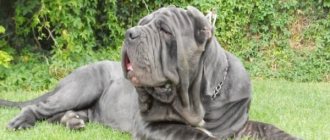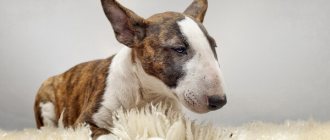The Turkmen Alabay is one of the varieties of the Central Asian Shepherd Dog, whose history goes back several thousand years and whose character traits and exterior were formed in natural conditions, without the participation of professional breeders and breeders.
These are one of those dogs that cannot be bought based only on external data - first of all, it is important to study the characteristics of their behavior, disposition and character.
Origin story and what it looks like in the photo
The first mentions of these dogs date back to the 11th century, but scientists have not been able to establish for certain the homeland of the breed: some believe that it is Tibet, others talk about the steppes of Manchuria, and others claim that the Turkmen Alabai originated in China.
There is no exact information about their ancestors.
It is believed that modern Turkmen Alabai descended from Tibetan mastiffs and Mongolian shepherd dogs.
At the same time, Central Asian legends say that the ancestors of the breed were dogs that looked like hyenas and received the nickname Syrtlon from the locals.
The history of the Turkmen Alabays, wolfhounds - a demonstration of the laws of natural selection . More than 5 thousand years. ago, the inhabitants of Central Asia needed dogs that would protect herds and shepherds from steppe wolves.
Alabais were perfect for this role - large, powerful and loyal, they coped well with the role of watchmen and security guards, thanks to which they quickly became popular among traders who were looking for dogs to guard caravans.
For this purpose, only the smartest, hardiest and strongest dogs were chosen..
Over time, Turkmen alabai spread throughout Central Asia and attracted the attention of breeders and breeders who planned to make their main task the protection of military and government facilities.
However, representatives of this breed turned out to be too wayward, freedom-loving and uncontrollable.
Alabai: why is it called that?
Now they are called Central Asian Shepherd Dogs. They are called Alabais in their homeland, Turkmenistan. The translation of this name is interpreted differently.
Some believe that this is from a respectful combination of two words: Ala - spots and Bai - rich. It turns out that this dog is rich in spots. There are very few truly pure white dogs in Turkmenistan. Mostly they are large, white, but with sparsely located black-red or red spots.
Another version interprets the first part of the word as scarlet. There are many words in the Turkmen language that contain two sounds joined together as “al”, which actually translates to bright red. However, in any language, the designation of color also carries an allegorical designation. For example, in Russian the red maiden is not the leader of the redskins, but a beauty.
The word scarlet means really red, but in the same sense - bright, noticeable, fiery. So there is also the opinion of some experts that the name alabai comes from two words - scarlet and bai, which can be interpreted as bright, noticeable like fire.
Finally, there is another very simple explanation. Once upon a time, the Turkmen people lived very isolated from others. From the south, the territory of this ethnic group was limited by the large Kopetdag mountains, from the north by the endless Karakum, and from the west by the Caspian Sea. Ethnic unity was possible only from the east, but there the mountains also played a dividing role.
The Turkmens simply had no other dogs except Alabais. The Turkmen villages of the Soviet period presented an amazing sight - only purebred dogs lived there. Apart from Alabais, there were no other dogs there. So the version was born that Alabai is just a dog.
Thus, alabai is:
- just a dog;
- spotted bay;
- scarlet bai.
If you combine all these linguistic models, it turns out that this is a dog, rich and big like a bai, spotted and bright, majestic and noticeable to everyone.
Interesting Facts
- Representatives of this breed are recognized as a national treasure of Turkmenistan, therefore they are prohibited from being exported outside the country.
- In 2022, the President of Turkmenistan presented a Turkmen Alabai puppy to V. Putin for his 65th birthday. The pet was given the nickname Faithful.
- The weight of the largest alabai in the world is more than 120 kg. The dog's name is Bulldozer, he lives in the Stavropol Territory.
Vaccinations
You should start vaccinating your dog during puppyhood. Vaccination can prevent major diseases to which an animal is susceptible.
vaccinations are carried out according to the schedule:
- 2 months. Puppies are vaccinated against distemper, enteritis, hepatitis, parainfluenza, leptospirosis;
- 3 months. The first vaccination is repeated;
- 6 months. Vaccination against rabies. Should be repeated once a year;
- 7 months. The first vaccination is repeated;
- 12 months. The first vaccination is repeated. Should be repeated once a year.
If vaccination against the disease is performed for the first time, the animal must be quarantined for 14 days. During this period, the dog’s body has time to produce antibodies that can resist the virus against which the vaccination was carried out.
Advice! After vaccination, the general condition of the animal may temporarily deteriorate. If your pet does not feel better the next day, you should immediately contact your veterinarian.
Alabais are ready to walk for hours, but you shouldn’t let them go alone
Description of pets
Turkmen Alabais are large dogs with a rather ferocious appearance and a difficult character. They are self-reliant, independent and smart, but at the same time they are stubborn and tend to act as they see fit, without trying to please anyone.
Therefore, it is not easy to train them - having decided that a command is impractical, they can refuse to carry it out and it is almost impossible to convince them otherwise.
Representatives of this breed are still used to this day as watchmen and guards of pastures and houses, especially in their ethnic homeland.
Possessing a massive build, thick coat and thick skin, these dogs are able to easily put to flight any intruder, be it a robber or a predatory animal.
They are not prone to aggression and most often only announce the visit of a stranger with a menacing growl, however, the innate desire for leadership and the developed instinct of territoriality if ineptly trained can make the Turkmen Alabais dangerous for weak people and children.
Behavioral specificity
The Turkmen wolfhound has a number of other behavioral features. It would seem that a character formed in the vast expanses of mountains, deserts and semi-deserts should be particularly aggressive. In these open spaces, people and livestock were in danger from natural disasters, the fangs of other predators, and most importantly, from other people. After all, in these parts there have long been robbers who traded not only in the theft of livestock and property, but also in the slave trade.
However, this dark past strangely affected the character of the Alabais, especially the Turkmen ones. If these dogs are close to the flock and their owners, then an approaching stranger will be stopped by a moderate, non-aggressive bark. This is just a warning that continues until the owner finds out what the person came with. If the situation is peaceful, then the Alabai will never show aggression towards a new person, allowing him to be in the given territory unhindered.
So these dogs have a generally positive attitude towards people. However, only until the person came to them in peace.
It’s another matter if these Alabai do not have a nearby object of protection and the will of the owner to guide them. In small Turkmen villages, where it is not customary to keep chain dogs, Alabais gather in packs and begin to guard the village itself, controlling its perimeter.
If suddenly, under the cover of darkness, when the inhabitants of the village are sleeping, a random traveler enters this territory, then the Alabai will receive him in their own way. A well-coordinated flock surrounds such a person, trying to get behind him. If the traveler’s nerves are strong and he does not run, then a characteristic carousel will form. The man, turning to face each of the dogs, constantly spins in place. Each dog, trying to get behind his back, is forced to run in a circle all the time. We must give these dogs their due, such a carousel does not last long. If it turns out that a person has strong nerves, does not use weapons, does not call for help, then the pack, with a sense of fulfilled duty, runs away on its security duties.
Character traits
Turkmen Alabais have a calm, balanced character and a stable psyche . These dogs combine a certain primitive animal strength and aristocracy.
They are devoted to their owner, without hesitation they will come to his defense in case of danger and will be ready to give their lives for him. But achieving such an attitude is not easy - it is important to be able to prove to the self-sufficient and self-confident Alabai people their leadership and superiority.
Representatives of this breed are very active and have a high degree of endurance, so it is important to provide them with regular walks that combine active games, running and other types of physical activity..
Lack of activity negatively affects not only the physical, but also the psychological health of the pet.
They are wary of strangers, with a high degree of suspicion, but they will not show aggression and rush at people if they do not see a direct threat emanating from them to themselves or their owner.
They are prone to dominant behavior; this is characteristic not only of adults, but also of puppies . Therefore, from the first days of your pet’s stay in the house, it is important to show him his place and make it clear that he is not the main one in the house.
Expert opinion
Kozhevin Semyon Kirillovich
Expert dog handler.
Despite the restrained power and strength, which is impossible not to notice, looking at the Turkmen Alabais, many may think that they are phlegmatic and generally submissive dogs to their owners. But this is far from true. It is almost impossible to achieve unconditional obedience from representatives of this breed. You can only count on partnerships and mutual respect, but only if the owner manages to prove his leadership. These dogs will never recognize the owner and leader of the pack in a person with a weak character. Therefore, only experienced dog breeders who are confident in their own abilities can own a Turkmen Alabai.
Territorial differences of Central Asian Shepherds
Dogs, which are called Central Asian Shepherds, are geographically divided into 3 parts. These are Uzbek, Tajik and Turkmen shepherd dogs. This division is not accidental. Folk breeds are formed not only by selection for the desired qualities, but also, to a large extent, by geographic isolation. All of the isolating barriers described above played their role in the genetic and phenotypic polishing of each of these variants of a single breed.
Dog breeders of the world received a ready-made breed, representatives of which were collected in auls and villages, in adyrs and takyrs, in the sands and on the slopes of the mountains of Central Asia
The largest Alabay was formed in Turkmenistan. It is difficult to say what exactly played a role in the selection, but the Turkmen Shepherd Dog of all Central Asian Shepherd Dogs is not only the largest, but also the calmest and most friendly. Despite the powerful isolating barrier in the form of the Caspian Sea, the herding dogs of Turkmenistan are very similar to the Caucasian Shepherd in many of their qualities. If you mentally remove the dense and long hair of the Caucasian Shepherd, as well as the fluffy tail, then the difference between these breeds will decrease significantly.
Advantages and disadvantages
Like representatives of other breeds, Turkmen Alabais have their own advantages and disadvantages.
The advantages of the breed include:
- developed security and guard instinct;
- absence of causeless and uncontrollable aggression;
- shepherd instinct;
- loyal attitude towards other pets and children;
- mind;
- endurance;
- performance;
- lack of specific requirements for maintenance and care;
- good health.
Flaws:
- need for regular walks and physical activity;
- the need for professional education and early socialization;
- heavy shedding.
In addition, these dogs, due to their high activity and large size, are not suitable for apartment living, and due to their stubbornness and willfulness, they are difficult to train.
Walk
The Turkmen Alabai needs daily physical activity. The animal is not suitable for keeping in an apartment. But even living in the open air and the ability to freely walk around the yard does not compensate for the dog’s need to walk. The owner must devote at least 2 hours daily to walks with the pet.
A dog always doesn't mind playing with its owner
Advice! You can diversify your time with your dog. It is not necessary to follow a step all the way. You can go for a run with the Alabai, play ball, or combine a walk with learning new elements of training.
You should not let your dog go for a walk alone. While defending territory, alabai can be dangerous to outsiders. In addition, representatives of the breed are prone to wandering. By letting the dog go free swimming, the owner risks losing it.
It is worth keeping your pet on a leash using a special dog harness .
Breed standard
To meet the breed standard, the Turkmen Alabai must have:
- massive, large, but proportional to the body head;
- widened muzzle with folds on the forehead;
- black nose;
- correct scissor bite;
- round, wide-set eyes;
- small hanging triangular ears;
- wide, muscular body, deep chest;
- strong straight limbs with developed muscles;
- high-set, sickle-shaped tail.
The main feature of the breed is the structure of the head, namely the presence of pronounced cheek bones, a flat and wide forehead.
Raising a Turkmen wolfhound
Alabai puppies are quite easy to raise and train. They are happy to make contact and obey their owner well. Only an experienced dog handler can retrain an adult dog that is accustomed to disobedience.
Having sensed a weakness in the character of its owner, the pet can take advantage of it. It won't necessarily be aggression. Not wanting to carry out any command, a cunning dog can pretend to be sick . Once you feel sorry for her, she will continue to use these techniques in the future. Therefore, in raising an Alabai, the main task is to achieve unquestioning obedience.
Turkmen alabai
From a very early age, Asians need to suppress aggression towards other dogs. They especially do not like small dogs. Therefore, from puppyhood these negative aspects must be overcome. A small pet should be taught to walk with other dogs and punished if it shows aggression. Otherwise, with a grown-up Alabai, it will be difficult to walk along the city streets and attend exhibitions.
If you have purchased a Turkmen wolfhound, it is advisable to take obedience training courses and special training courses. After them, you can easily train your pet as a bodyguard dog , and you won’t be afraid to walk with him even along the darkest streets of the city.
Color variations
The coat of Turkmen Alabais can be white , fawn, brown, red, gray and black . Brindle color is also acceptable, but is quite rare.
Who is the breed not suitable for?
Kangal dogs are not recommended for city residents and beginners in dog breeding. From the description of the Kangal Shepherd, you can immediately understand that such a huge dog will feel uncomfortable in the limited space of a city apartment.
Also, those who have no experience raising dogs should not purchase Kangal puppies. Only an experienced person who has experience in training and education, and also has a strong character, can cope with such a pet.
Attitude towards children and does he get along with other pets?
Representatives of this breed are loyal and have great patience with children, but only if they respect their personal boundaries.
Therefore, it is extremely important for parents to explain to their children that this is not a toy, but a living creature with a rather obstinate character.
CAREFULLY!
You should not leave the child alone with the dog - the alabai can accidentally push and injure the baby.
They get along well with pets that grew up with them, be it another dog, cat or rodent, but only after they have proven their leadership to them.
They treat other people's dogs and cats with hostility and even aggression.
Education and training
! important! The breed is a species with late development; the dog is fully grown only by the age of 3, this must be taken into account when training.
Raising a dog begins at 2-3 months of life:
- To begin with, the puppy is taught the most basic habits, accustomed to a collar, leash, and muzzle.
- learn to communicate with strangers and animals;
- It is necessary to teach the child to calmly react to loud sounds and passing cars;
- When possible, new places are often shown.
Next, they teach new simple commands, train, gradually increasing the load. For full training, the dog must be trained with a specialist. When raising, cruelty is excluded, since Alabai have a soft soul; excessive cruelty will forever turn a faithful dog into an uncontrollable animal.
Care and maintenance
These dogs are not suitable for apartment living . For this, they are too large and overly active; in such conditions they will not be able to feel comfortable.
It is better to keep Turkmen Alabais in the local area of a private house. They easily tolerate temperature changes and can live outside throughout the year if you equip them with an enclosure or booth.
In hot weather, your pet can get heatstroke, so it is important to make a canopy in the yard where he can hide from the sun.
Ears
Every 2 weeks, wipe your ears with a cotton pad soaked in a special lotion or hydrogen peroxide solution to remove accumulated dust, dirt and wax.
Claws
If the claws do not grind down on their own, you need to trim them with a guillotine nail clipper 1-2 times a month . This must be done carefully so as not to touch the living part of the claw and blood vessels.
Eyes
Wipe weekly with a soft cloth or napkin previously soaked in tea leaves, chamomile infusion or simply boiled water.
Teeth
To prevent the formation of plaque and stones, which can lead to the development of periodontal disease and other diseases, it is necessary to examine the dog’s oral cavity once every 1-2 weeks and brush its teeth with a special brush and paste.
Wool and bathing
The coat of Alabais is not prone to the formation of tangles, so you need to comb them with special mittens and brushes no more than 1-2 times a week, during spring molting - daily, using a slicker brush or furminator.
You should bathe your pet no more than once a quarter; more frequent washing can negatively affect the coat’s ability to repel dirt and clean itself.
Walk
Turkmen Alabays need to be walked 2 times a day . Each walk should last at least 1.5-2 hours and include active games, running and other physical activities.
Character and work in specialty
This dog is not called a wolfhound for nothing. In order to herd herds of sheep in a deserted area, you must be able to:
- make rams, goats, cows, horses, camels, donkeys and other farm animals obey the shepherd dog;
- protect the property of your owner from attacks by people;
- protect your charges from wolves, hyenas, leopards (and earlier also from the teeth of tigers that lived in the mountains and foothills of the Kopetdag and on the Kaplankyr plateau);
- take your herd away from other dogs.
Life expectancy and major diseases
Turkmen Alabai are long-livers , on average they live 12-15 years . In general, these dogs are in good health and resistant to most diseases common among other breeds.
However, their large size makes them prone to the development of hip and knee dysplasia, which most often occurs in older dogs.
Pathologies such as arthritis, arthrosis, tendinitis and myositis are also possible, and a sedentary lifestyle and lack of the required amount of physical activity can lead to obesity, arrhythmia and heart attack.
Mixed breeds may have a coat that is too short and not thick enough, a disproportionate physique, ophthalmological diseases and pathologies of the endocrine system.
Genetic diseases include cryptorchidism in males and infertility in females..
Health
In most cases, Central Asian Shepherds are considered a healthy and strong breed. They have virtually no hereditary diseases. For the first 12 weeks, puppies are in excellent health, which is protected by the immunity transmitted from the mother. After this age, dogs can be susceptible to viral diseases, so it is extremely important to carefully monitor the health of your four-legged pet.
It will be necessary to carry out vaccination strictly according to schedule. Veterinarians recommend, in addition to standard vaccinations, also against piroplasmosis, infectious tracheobronchitis, and parainfluenza.
Nutritional Features
You can feed Turkmen Alabais with both industrial feed and natural products; the choice depends on the preferences and convenience of the owner. It is only important to keep your diet balanced and not mix both types of nutrition.
Having chosen natural feeding, you must include in the dog’s menu:
- lean meat, preferably beef or veal;
- offal;
- seasonal vegetables, fruits and herbs;
- oatmeal, buckwheat, rice porridge;
- sea fish;
- eggs;
- dairy products.
You can't feed the dog:
- tubular bones;
- pearl barley and semolina porridge;
- onions and garlic;
- potatoes, legumes;
- pickles, marinades, spices;
- sausages, pasta and bakery products.
IMPORTANT!
It is also prohibited to give representatives of this breed leftovers from the common table, smoked and fried foods.
If the choice falls on industrial food, then preference should be given to high-quality products developed taking into account the needs and characteristics of large breed dogs.
Popular food brands are Royal Canin, ProNature, Pro Plan, Hills, Acana, Orijen, Savarra.
Common diseases of Alabai
Since wolfhounds have a large body mass that puts pressure on their limbs, they often suffer from myositis, arthrosis, tendonitis, and arthritis. Good exercise and the addition of vitamins and minerals to the diet are the prevention of these diseases.
Insufficient mobility of an apartment dog leads to many cardiovascular diseases. Therefore, if your pet begins to gain excess weight, it is worth increasing the number and duration of walks , during which the dog should actively move.
Genetic anomalies of Turkmen Alabais include infertility in females and cryptorchidism in males. There are different eye colors and deviations from the number of teeth.
In our country, Turkmen Alabais are quite popular, so you can buy a puppy without any problems. If you want to buy a real wolfhound with typical features of the breed, then you need to trace its pedigree. But if you just like Turkmen Alabai, and you want to have him as a friend and family pet, then take the puppy you like and raise him at your own discretion.
How to choose? Boy or girl?
Before purchasing a puppy, you should carefully examine it to ensure its health and proper development.
The puppy should be moderately well-fed, without signs of excess weight or exhaustion, active, playful and inquisitive . He should have a cold and moist nose, clean eyes with no signs of excessive lacrimation or suppuration.
The baby should not have dandruff, rashes, inflammation, or discharge from the eyes, nose or ears. All these are signs of health problems.
The breed-standard puppy has a wide head, a scissor bite, small ears and round eyes..
Bitches are more sociable and calm, they get along better with children, but due to their innate cunning, they are less amenable to training.
Males, on the other hand, are distinguished by their pronounced stubbornness and willfulness; their habit of making decisions on their own is almost impossible to eradicate..
Description and characteristics of the breed
Armenian gampr (wolfhound): comparison with alabai
Kangal is a very large breed of dog. At the withers, these animals reach a height of 70 to 90 cm. At the same time, they weigh from 50 to 70 kg. Despite such impressive data, the dogs are not fat, but rather harmoniously built.
Note! Currently, the Kangal is recognized among dogs as having the most powerful bite in the world.
The physique of galangal dogs is strong, the muscles are well developed. Their movements are smooth and swift. The forehead is convex with a pronounced transverse groove. Correct scissor bite. The jaws are strong, the teeth are white and large.
The eyes are almond-shaped, medium to small in size. Set wide apart with a serious, attentive gaze. The large nose is brown or black depending on the color of the coat.
The back is wide and straight. The shoulder blades are tilted forward. The coat can be either short or long. At the same time, it fits tightly to the skin and has a dense, abundant undercoat. Gray-yellow, gray-brown and brown-yellow colors are allowed.
Interesting! A distinctive feature of the breed is the dog's muzzle covered with a black mask and ears with black markings.
Anatolian Shepherd is a large guard dog
Dog intelligence
The Central Asian Shepherd Dog or Alabai has a high level of intelligence. They understand all commands; learning difficulties may arise only due to their independent nature. Alabais are smart, can predict the actions of the enemy and make independent decisions without waiting for the owner’s command.
Central Asians can get along with other pets
Training an Alabai puppy
The puppy should master the commands “lie down” and “sit” well before the age of 7 months. The leading command that must be practiced throughout the year should be a ban - “no”. In addition, the puppy needs to be taught the command “near”, “stand”, “come to me”. The “place” order must be executed in front of a juicy piece of meat. If the pet does not give in to temptation, succumbing to the authority of the owner, then this dog has been reached.
From the first months of life, it is necessary to teach the Alabai to calmly tolerate any manipulations by the owner with the jaw and food. A key role at the exhibition will be played by the ability to fearlessly put your hand into the animal’s mouth and show the teeth of your four-legged friend.
A failure in upbringing is indicated by the dog’s behavior. An alarm bell is protecting a bowl of food from the owner. This indicates a complete lack of trust on the part of the pet. Moreover, the blame lies only with the person.

